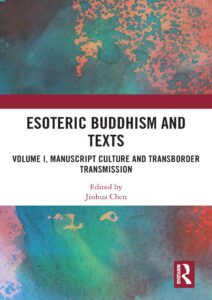 We are pleased to announce the release of Esoteric Buddhism and Texts Volume I, Manuscript Culture and Transborder Transmission, published by Routledge.
We are pleased to announce the release of Esoteric Buddhism and Texts Volume I, Manuscript Culture and Transborder Transmission, published by Routledge.
Book details:
Edited by Jinhua Chen. Esoteric Buddhism and Texts Volume I, Manuscript Culture and Transborder Transmission. Routledge, 2024. ISBN: 9781032563206. Price: $170 USD hardback, $48.71 ebook.
About the book:
This book explores trans-cultural and cross-border transmission and transformation of Esoteric Buddhism in East Asia, focusing on its manuscript culture and the transborder transmission of Esoteric Buddhist texts.
In East Asia, Esoteric Buddhism’s influences can be seen across all levels of society: not only in that it achieved a recognizable sectarian identity, but also because elements of esoteric teachings were absorbed by other religious schools, influencing their philosophical tenets and everyday practices. The influence was not confined to the religious sphere: scholars have been paying more and more attention to the significance of Tang Esoteric Buddhism in relation to material culture and the dissemination of Esoteric Buddhist technologies in South, Central, and East Asia. No matter how one looks at a maṇḍala—an integral feature of esoteric practice—or the uncannily expressive statues of Buddhas, Bodhisattvas or Yidam that come in all shapes and sizes, or the murals that depict the variegated, mysterious themes of the esoteric tradition, one can always recognise the profound connection between art and Esoteric Buddhism. Esoteric Iifluences also abound in East Asian literature across different genres, displaying its unique characters both in poetry and prose. Likewise, in architecture, one can readily make out the enigmatic, colorful and distinctive elements characteristic of the esoteric tradition. Monks initiated into the esoteric lineages not only brought Buddhist classics and practices to China but also advanced knowledge in astronomy, calendarial calculations and mathematical theories.
The chapters in this volume focus on two major aspects of textual Esoteric Buddhism—its manuscript culture and transborder transmission. This book will be beneficial to advanced students and researchers interested in Religious Studies, History and Buddhist studies. It was originally published as a special issue of Studies in Chinese Religions.
Table of Content:
- Preface
Jinhua Chen
Part I: Esoteric Manuscript Culture
- Dunhuang was not isolated: examples such as ‘Master Yixing sets up earth-wheel lamps’ and others from Yunnan
Chong Hou - Following medieval Chinese Buddhist precedents with ritual practices using exoteric Buddhist scriptures (kengyō 顕経) from Amanosan Kongōji 天野山金剛寺 and Shinpukuji 真福寺 in medieval Japan
George A. Keyworth - Reception and transformation of the Huiji Jin’gang shuo shentong daman tuoluoni fashu Lingyao men: the discovery and significance of medieval Japanese scripture manuscripts
Limei Chi - A preliminary study on one folio of Tibetan tantric ritual text recently collected by the national library of China
Saerji - Tangut Buddhism and the Bodhicittotpādasamādānavidhi
Kirill Solonin and Haoyue Xie
Part II: Transborder Transmission
- The late Tang esoteric manual for Abhiṣeka: an introduction, analysis, and translation of the Engyō Nyūdan
Yang Wu - A (presumably Chinese) tantric scripture and its Japanese exegesis: the Yuqi Jing 瑜祇經 and the practices of the Yogin
Lucia Dolce - On the integration of Chinese, Tibetan, exoteric and esoteric Buddhism in the Tangut Kingdom
Weirong Shen - Kūkai’s transcultural rhetoric of prayer: on his writings inspired by the Chinese “prayer text” (yuanwen 願文)
Nicholas Morrow Williams - Kūkai 空海 (774–835) and Saichō’s 最澄 (766–822) theories on gotra 種姓 (caste)
Zijie Li
- Index
Click here to the original posting








